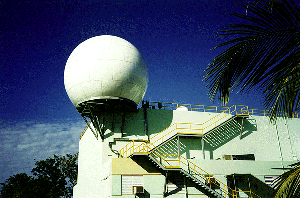

Mission Status Report #19 Star Date: September 24, 1999 NOTE: Mission Status Reports on the web page will continue roughly once a week, as events unfold. 

The Satellite Control Center at JHU (left) and a view of the FUSE ground station in Puerto Rico (right). (Click either image to see larger version.)
Spiral Search Locates FUSE Spectrograph AperturesFUSE In-Orbit Checkout continued this week with a relatively smooth operational period. Ground contacts through the antenna at University of Puerto Rico have remained very solid and dependable, and target acquisitions (including several autonomous acquisitions when not in contact with the ground) have been going smoothly, with one exception: acquisitions (or re-acquisitions after a target has been behind the earth as viewed from FUSE) have sometimes failed during the daylit portion of the orbit due to scattered light. We have not yet been able to fully characterize this problem, and so as a precautionary measure we are currently minimizing the use of acquisitions in daylight viewing intervals. With many of our operations problems behind us, we were finally able to run an important test this week: a so-called "spiral search." Recall that FUSE has four separate telescope mirrors, which must be carefully aligned and focussed with respect to each other for FUSE to have full capability. Since our FES Guide Camera only views the field of view of ONE of the telescopes,* we have to "find" where the other telescopes are pointing using an indirect method. This method involved placing a UV-bright star (recall the FUSE spectrograph only "sees" UV light, while the camera looks at optical wavelengths!) in the 30 arcsec square aperture of the one field of view we could see directly, and stepping the star sequentially through a set of positions that slowly spirals outward until we "see" the star in the other telescopes! (When we see the star's light, it means the star is in the 30 arcsec spectrograph aperture corresponding to each telescope.) By analyzing this data, we can in principle determine how to move the mirrors relative to each other to line them up. (Whew! It's almost as hard to describe this as it is to do it!) Last Friday we were able to execute this spiral search with a 122 step pattern in the spiral. (Note: this means 122 small slew motions and successful reacquisitions of guide stars, which really provides some confidence that the software fix uplinked to the FES guide camera is working!) Analysis of the data located the relative positions of all four telescopes (yay!) and mirror motions to date have gotten 3 of the four telescopes aligned approximately (to about 25 arcsec). The fourth "rogue" channel has temporarily escaped, for reasons that are under study, but we hope to get the fourth mirror into the fold this weekend. This is a very significant step! When rough alignment is achieved, then we proceed with a finer step pattern that aligns the telescope to 5 arcsec, and then go through an iterative procedure of focus motions and realignment. (BOTH focus and alignment involve moving the mirrors!) Once we are in a focussed and aligned state, only minor corrective motions should be needed periodically for the rest of FUSE's three year mission. A good part of next week will be needed to perform an important code load of our instrument computer, and subsequent checkout. This version of the operating code fixes a number of bugs and features encountered earlier in the checkout phase, and should largely fix the memory fragmentation problem discussed in an earlier report. It has been extensively tested on the ground by our technical staff both at JHU and at the Applied Physics Lab, and we hope for a smooth transition to using the new code.
*(In reality, the "backup" FES camera looks at one of the other mirrors; by taking pictures with both cameras in sequence, we were actually able to determine the relative positions of those two mirrors directly! But that still left two mirrors at unknown positions!)
Reported by: Bill Blair, Chief of Mission Planning
|